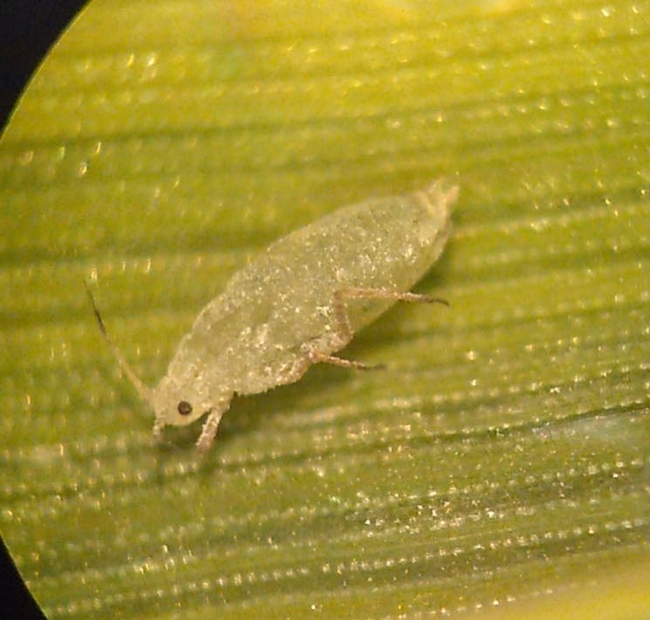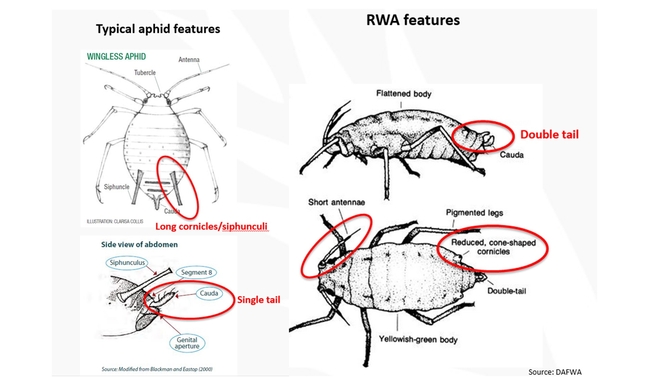Russian wheat aphids (RWA) have been sighted in some parts of western Yolo County and the Delta. RWA is an invasive species of aphid that caused a fair amount of consternation when it was introduced in the mid-80's. While some RWA is now common from year to year in California, RWA is not usually problematic for fall-planted wheat because most wheat is already in the late-boot stage by the time RWA populations are increasing, limiting their damage. However, due to precipitation patterns in the Sacramento Valley this season, some growers may have planted (or replanted) their wheat later in the season. As a result, there may be greater chances for crop damage from RWA this season on these younger stands.
Above: Russian wheat aphid on wheat leaf. Note the supracaudal process on the back end of the aphid. This individual has developed a waxy covering, which is typical among adults. Photo: Konrad Mathesius, UCCE
Symptoms of phytotoxicity caused by the aphids are characterized by long white streaks in grass leaves that run parallel to leaf veins. Leaves will often appear tightly curled and will fail to unfold, instead remaining upright in a manner that resembles an onion leaf. Later in the season RWA feeding can also cause spikes to become snagged in the flag leaf. Both of these can impact grain yield and grain quality if population levels are high enough. For a more detailed description and treatment options, refer to the UC IPM website on Russian wheat aphid.
Russian wheat aphids can be distinguished from other aphids by the presence of a supracaudal process. This is basically an extra bump on their backside ‘tail' (Figure 1). Other features that identify the RWA are their elongated body shape relative to other aphid species as well as stubby translucent cornicles or ‘tail pipes' that are often longer and darker in other aphid species. (Figure 1) UC IPM also has an aphid diagnostic tool that can be useful in distinguishing other species of aphids.
Figure 1: Russian Wheat Aphid physiology relative to other common aphid species.
Image: Department of Agriculture and Food Western Australia
UC IPM recommends treating for aphids if aphid density reaches 10 and 20 individuals per tiller at first node and boot, respectively. (Table 1). Yield reduction varies somewhat depending on the RWA population size and the yield potential and growth stage of the wheat. Studies from Texas indicate that yield losses are roughly 0.48% for every 1% of tillers infested. However, agronomic and climatic conditions in Texas are not the same as those in California so the relative economic impact with higher-density plantings in California might lead to different outcomes.
|
Plant Growth Stage |
Number of Aphids per Plant or Tiller |
|
two leaf |
5 (per plant) |
|
early tillering |
5 (per tiller) |
|
late tillering |
10 (per tiller) |
|
first node |
10 (per tiller) |
|
boot |
20 (per tiller) |
|
head exertion and later |
30 (per tiller) |
Table 1: Treatment thresholds for Russian Wheat Aphid in Wheat
In most cases treatment is not economical, and in some cases spray applications can knock down beneficial insects, such as ladybird beetles, which often increase quickly in response to the growing prey population. Because aphids can reproduce faster than their predators, the absence or hindrance of a predatory population due to insecticide applications can result in even greater explosions of aphids later in the season. This dilemma is compounded by the fact that RWA is often somewhat shielded from contact with insecticide due to the innate protective nature of the curled leaf environment where nymphs often reside.
In deciding whether or not to treat, monitoring for RWA should take place over the course of several days to a week. Growers or PCAs should select plants from several representative sections of the field, regardless of whether or not they see symptoms in that particular area. Sampling should be carried out 2-3 times in the course of a week as populations can rise or fall fairly quickly. Random sampling of plants (sampling by counting steps or throwing an easily-retrievable object behind your head) will ensure that the decision to spray is unbiased. Be sure to unroll the curled leaves when looking for RWA individuals.
1) Retrieve 10 samples at random from 4 separate sections of the field
2) Count and record the Russian Wheat Aphids present per tiller (typically identified as the smaller light green aphids relative to more common bird cherry oat and corn aphid). These may also be greenbugs but the curled and striped symptoms of samples can be used to confirm RWA presence.
3) Average out the number of aphids per tiller by adding up all the aphids and dividing that number by the number of total tillers that you've examined.
4) Repeat this process later in the week to see if populations are rising or falling significantly. In both cases keep an eye out for ladybird beetle eggs or larvae (bright yellow, upright, oval eggs clustered together often on the underside of newer leaves.
Complete information on RWA and treatment options can be found on the UC IPM website. Any growers who think they may have RWA in their winter grasses should feel free to reach out to their local farm advisor or local ag commissioner's office.
References:
UCIPM:
Dept. of Agriculture and Food West Australia
Archer and Bynum (1992)

